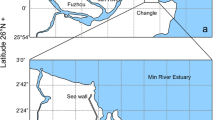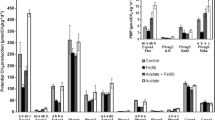Abstract
For energetic reasons, iron reduction suppresses methanogenesis in tidal freshwater wetlands; however, when iron reduction is limited by iron oxide availability, methanogenesis dominates anaerobic carbon mineralization. Plants can mediate this microbial competition by releasing oxygen into the rhizosphere and supplying oxidized iron for iron reducers. We utilized a plant removal experiment in two wetland sites to test the hypothesis that, in the absence of plants, rates of iron reduction would be diminished, allowing methanogenesis to dominate anaerobic metabolism. In both sites, methanogenesis was the primary anaerobic mineralization pathway, with iron reduction dominating only early and late in the growing season in the site with a less organic soil. These patterns were not influenced by the presence of plants, demonstrating that plants were not a key control of microbial metabolism. Instead, we suggest that site conditions, including soil chemistry, and temperature are important controls of the pathways of anaerobic metabolism.





Similar content being viewed by others
References
Bartlett, K.B., D.S. Bartlett, R.C. Harriss, and D.I. Sebacher. 1987. Methane emissions along a salt marsh salinity gradient. Biogeochemistry 4: 183–202.
Bridgham, S.D., J.P. Megonigal, J.K. Keller, N.B. Bliss, and C. Trettin. 2006. The carbon balance of North American wetlands. Wetlands 26: 889–916.
Bullock A., A.E. Sutton-Grier, and J.P. Megonigal 2012. Anaerobic metabolism in tidal freswhater wetlands: II. Temperature sensitivy of microbial iron cycling. Estuaries and Coasts. doi:10.1007/s12237-012-9536-5.
Conrad, R. 1999. Contribution of hydrogen to methane production and control of hydrogen concentrations in methanogenic soils and sediments. FEMS Microbiology Ecology 28: 193–202.
Denman K.L., et al. 2007. Couplings Between Changes in the Climate System and Biogeochemistry. In Climate Change 2007: The Physical Science Basis. Contribution of Working Group I to the Fourth Assessment Report of the Intergovernmental Panel on Climate Change eds Solomon S, D. Qin, M. Manning, Z. Chen, M. Marquis, K.B. Averyt, M.Tignor and H.L. Miller, Cambridge, United Kingdom and New York, NY, USA: Cambridge University Press.
Ding, W., Z. Cai, and H. Tsuruta. 2005. Plant species effects on methane emissions from freshwater marshes. Atmospheric Environment 39: 3199–3027.
Eaton A.D., L.S. Clesceri, and A.E. Greenberg. 1995. Standard methods for the examination of water and wastewater. Washington, DC: American Public Health Association.
Emerson D., W. Bellows, J.K. Keller, A.E. Sutton-Grier, and J.P. Megonigal. 2012. Anaerobic metabolism in tidal freswhater wetlands: III. Effects of plant removal on Archaeal microbial communities. Estuaries and Coasts. doi:10.1007/s12237-012-9496-9.
Forster, P., V. Ramaswamy, P. Artaxo, T. Berntsen, R. Betts, D.W. Fahey, J. Haywood, J. Lean, D.C. Lowe, G. Myhre, J. Nganga, R. Prinn, G. Raga, M. Schulz, and R. Van Dorland. 2007. Changes in atmospheric constituents and in radiative forcing. In Climate change 2007: The physical science basis. Contribution of working group I to the fourth assessment report of the intergovernmental panel on climate change, eds. Solomon, S., D. Qin, M. Manning, Z. Chen, M. Marquis, K.B. Averyt, M. Tignor and H.L. Miller, Cambridge, United Kingdom and New York, NY, USA: Cambridge University Press.
Giblin, A.E., and R.W. Howarth. 1984. Porewater evidence for a dynamic sedimentary iron cycle in salt marshes. Limnology and Oceanography 29: 47–63.
Keller, J.K., A.A. Wolf, P.B. Weisenhorn, B.G. Drake, and J.P. Megonigal. 2009. Elevated CO2 affects porewater chemistry in a brackish marsh. Biogeochemistry 96: 101–117.
Kelley, C.A., C.S. Martens, and J.P. Chanton. 1990. Variations in sedimentary carbon remineralization rates in the White Oak River esturary, North Carolina. Limnology and Oceanography 35: 372–383.
Kostka, J.E., and G.W. Luther. 1995. Seasonal cycling of Fe in saltmarsh sediments. Biogeochemistry 29: 159–181.
Laanbroek, H.J. 2010. Methane emission from natural wetlands: interplay between emergent macrophytes and soil microbial processes. A mini-review. Annals of Botany 105: 141–153.
Lovley, D.R., and E.J.P. Phillips. 1986a. Organic matter mineralization with reduction of ferric iron in anaerobic sediments. Applied and Environmental Microbiology 51: 683–689.
Lovley, D.R., and E.J.P. Phillips. 1986b. Availability of ferric iron for microbial reduction in bottom sediments of the freshwater tidal Potomac River. Applied and Environmental Microbiology 52: 751–757.
Ma, S., G.W. Luther, J. Keller, A.S. Madison, E. Metzger, J.P. Megonigal, and D. Emerson. 2008. Solid-state Au/Hg microelectrodes for the investigation of Fe and Mn cycling in a freshwater wetland: implications for methane production. Electranalysis 20: 233–293.
Marsh A.S., D.P. Rasse, B.G. Drake, and J.P. Megonigal. 2005. Effect of elevated CO2 on carbon pools and fluxes in a brackish marsh. Estuaries 28: 694–704.
Megonigal J.P., and S.C. Neubauer. 2009. Biogeochemistry of tidal freshwater wetlands. In Coastal wetlands: an integrated ecosystem approach, eds Perillo G, Wolanski E, Cahoon D, Brinson M, Elsevier.
Megonigal, J.P., M.E. Hines, and P.T. Visscher. 2004. Anaerobic metabolism: linkages to trace gases and aerobic processes. In Biogeochemistry, ed. W.H. Schlesinger, 317–424. Oxford: Elsevier-Pergamon.
Neubauer, S.C., D. Emerson, and J.P. Megonigal. 2002. Life at the energetic edge: kinetics of circumneutral iron oxidation by lithotrophic iron-oxidizing bacteria isolated from the wetland-plant rhizosphere. Applied and Environmental Microbiology 68: 3988–3995.
Neubauer, S.C., K. Givler, S.K. Valentine, and J.P. Megonigal. 2005. Seasonal patterns and plant-mediated controls of subsurface wetland biogeochemistry. Ecology 86: 3334–3344.
Phillips, E.J.P., and D.R. Lovley. 1987. Determination of Fe(III) and Fe(II) in oxalate extracts of sediment. Soil Science Society of America Journal 51: 938–941.
Poffenbarger, H.J., B.A. Needelman, and J.P. Megonigal. 2011. Salinity influence on methane emissions from tidal marshes. Wetlands 31: 831–842.
Roden, E.E. 2003. Diversion of electron flow from methanogenesis to crystalline Fe(III) oxide reduction in carbon-limited cultrues of wetalnd sediment mciroorganisms. Applied and Environmental Microbiology 69: 5702–5706.
Roden, E.E., and R.G. Wetzel. 1996. Organic carbon oxidation and suppression of methane production by microbial Fe(III) oxide reduction in vegetated and unvegetated freshwater sediments. Limnology and Oceanography 41: 1733–1748.
Roden, E.E., and R.G. Wetzel. 2002. Kinetics of microbial Fe(III) oxide reduction in freshwater wetland sediments. Limnology and Oceanography 47: 198–211.
Roden, E.E., and R.G. Wetzel. 2003. Competition between Fe(III)-reducing and methanogenic bacteria for acetate in iron-rich freshwater sediments. Microbial Ecology 45: 252–258.
Sutton-Grier, A.E., and J.P. Megonigal. 2011. Plant species traits regulate methane production in freshwater wetland soils. Soil Biology and Biochemistry 43: 413–420.
Taylor, G.J., A.A. Crowder, and R. Rodden. 1984. Formation and morphology of an iron plaque on the roots of Typha latifolia L. grown in solution culture. American Journal of Botany 71: 666–675.
van Bodegom, P., J. Goudriaan, and P. Leffelaar. 2001. A mechanistic model on methane oxidation in a rice rhizosphere. Biogeochemistry 55: 145–177.
van der Nat, F.-J., and J.J. Middelburg. 1998. Effects of two common macrophytes on methane dynamics in freshwater sediments. Biogeochemistry 43: 79–104.
van der Nat, F.J., and J.J. Middelburg. 2000. Methane emission from tidal freshwater marshes. Biogeochemistry 49: 103–121.
Weiss, J.V., D. Emerson, and J.P. Megonigal. 2004. Geochemical control of microbial Fe(III) reduction potential in wetlands: comparison of the rhizosphere and non-rhizosphere soil. FEMS Microbiology Ecology 48: 89–100.
Whigham D.F. 2009. Primary production in tidal freshwater wetlands. In Tidal Freshwater Wetlands, eds Barendregt A, Whigham D, Baldwin A, 115-122. Backhuys Publishers, Leiden; Margraf Publishers, Weikersheim.
Windham-Myers L., M. Marvin-Dipasquale, D.P. Krabbenhoft, J.L. Agee, M.H. Cox, P. Heredia-Middleton, C. Coates, and E. Kakouros. 2009. Experimental removal of wetland emergent vegetation leads to decreased methylmercury production in surface sediments. Journal of Geophysical Research 114: G00C05.
Acknowledgments
Chris Swarth at the Jug Bay Wetlands Sanctuary allowed unfettered access to our research sites for this project. We thank Jim Duls, Nick Mudd, Lucinda Williams, Pamela Weisenhorn, Sara McQueeney, Kyle Chambers, and Eric Pfoutz for assistance with field and laboratory work on this project. Comments from two anonymous reviewers greatly improved this manuscript. This research was supported by NSF DEB-0516400 to JPM and Smithsonian Post-Doctoral Fellowships to JKK and AES-G.
Author information
Authors and Affiliations
Corresponding author
Rights and permissions
About this article
Cite this article
Keller, J.K., Sutton-Grier, A.E., Bullock, A.L. et al. Anaerobic Metabolism in Tidal Freshwater Wetlands: I. Plant Removal Effects on Iron Reduction and Methanogenesis. Estuaries and Coasts 36, 457–470 (2013). https://doi.org/10.1007/s12237-012-9527-6
Received:
Revised:
Accepted:
Published:
Issue Date:
DOI: https://doi.org/10.1007/s12237-012-9527-6




